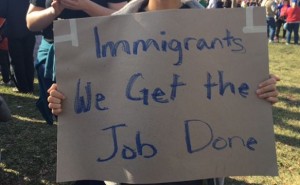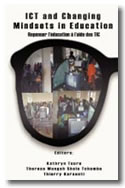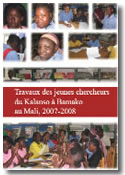Immigrants We Get the Job Done February 2, 2017
 At a recent Women’s March in Kansas City, at Washington Square Park, I saw a woman holding a sign saying “Immigrants We Get the Job Done.” I have found this to be true, especially ever since I graduated from the University of Kansas in political science and started my professional life working in refugee resettlement in New York City in 1986. And so, back to the Kansas City area after working in West and Central Africa for many years, I am happy to see how Kansas Citians welcome immigrants and refugees and am also dismayed by fears about newcomers, when most of us are indeed relatively new newcomers. And it seems that the fears are contrary to rhetoric about economic growth. I am thus sharing section 7 of a 2014 report on the economic impact of immigration in Kansas City. I hope you find it informative.
At a recent Women’s March in Kansas City, at Washington Square Park, I saw a woman holding a sign saying “Immigrants We Get the Job Done.” I have found this to be true, especially ever since I graduated from the University of Kansas in political science and started my professional life working in refugee resettlement in New York City in 1986. And so, back to the Kansas City area after working in West and Central Africa for many years, I am happy to see how Kansas Citians welcome immigrants and refugees and am also dismayed by fears about newcomers, when most of us are indeed relatively new newcomers. And it seems that the fears are contrary to rhetoric about economic growth. I am thus sharing section 7 of a 2014 report on the economic impact of immigration in Kansas City. I hope you find it informative.
Report on Economic impact of immigration in Kansas City and the bi-state region
Section 7: Conclusions about the Economic Impact of Immigrants in Kansas, Missouri and the KC Metro (pp. 50-51)
Kansas, Missouri, and the KC Metro have lower shares of immigrants than the US or comparable metropolitan areas. The region also has lower shares of H1B visa holders, permanent residents, and unauthorized immigrants. In both states, immigrants are just as likely as natives to be employed and participate in the labor force, although there are gender differences in the composition of the immigrant and native-born labor forces. Immigrants are more likely to have lower skills (less than a high school degree) or higher skills (graduate degrees) than natives in the two states. Thus it is not surprising that we find no significant negative effects of immigrants on population and employment growth in our estimated models.
Based on our metropolitan area regressions, the KC Metro would benefit from additional immigrants in terms of population growth, wages, and employment. Compared to many other mid-sized metropolitan areas in our region, the KC Metro has a much smaller share of immigrants. Thus, Kansas City has the capacity to absorb larger numbers of immigrants without experiencing adverse impacts on wages and employment.
In the state of Kansas, immigrants have increased the population in areas of the state that historically have experienced population declines. Many of these immigrants have settled in the southwestern part of the state to work in agriculture-based industries such as dairies and meatpacking. To the extent that population growth is a key contributor to economic growth, policies designed to encourage immigration may pay dividends for the state. In contrast, adopting policies that discourage immigration will likely have a negative impact on population, employment, and economic growth.
The state of Missouri has a very low share of immigrants compared to the nation as a whole and the state of Kansas. Given this low share, Missouri has the capacity to absorb many more immigrants than it currently does. Higher rates of immigration may provide one potential explanation for the growth of the KC Metro economy compared with the stagnation of the St. Louis economy.
The entire region would benefit from an increase in skilled immigrants. Visa flows by state indicate that both Kansas and Missouri attract fewer H1B high-skilled immigrants. Although immigrants are more likely to become entrepreneurs than natives in the country as a whole, that is not the case in the states of Kansas and Missouri. Skilled immigrants are more likely than skilled natives to become entrepreneurs and own small firms. Furthermore, small firms and entrepreneurial ventures are more likely to expand and generate greater economic growth (Kauffman Foundation). Thus, policies designed to attract skilled immigrants would bolster the regional economy.
Overall, our statistical analysis finds that immigrants add to the population and contribute to economic growth in the states of Kansas and Missouri and the KC Metro. We find no evidence that immigrants displace native population or decrease employment. In fact, we find the opposite, that immigrants increase the population and employment rate of metropolitan areas in the United States.
—–
The above is an expert (pp. 50-51) from the following report:
Ginther, D. K., Oslund, P. C., Boden, J. (2014). Economic impact of immigration in Kansas City and the bi-state region. Center for Science Technology and Economic Policy, Institute for Policy and Social Research, University of Kansas.
Full report available here: https://kuscholarworks.ku.edu/handle/1808/17096


